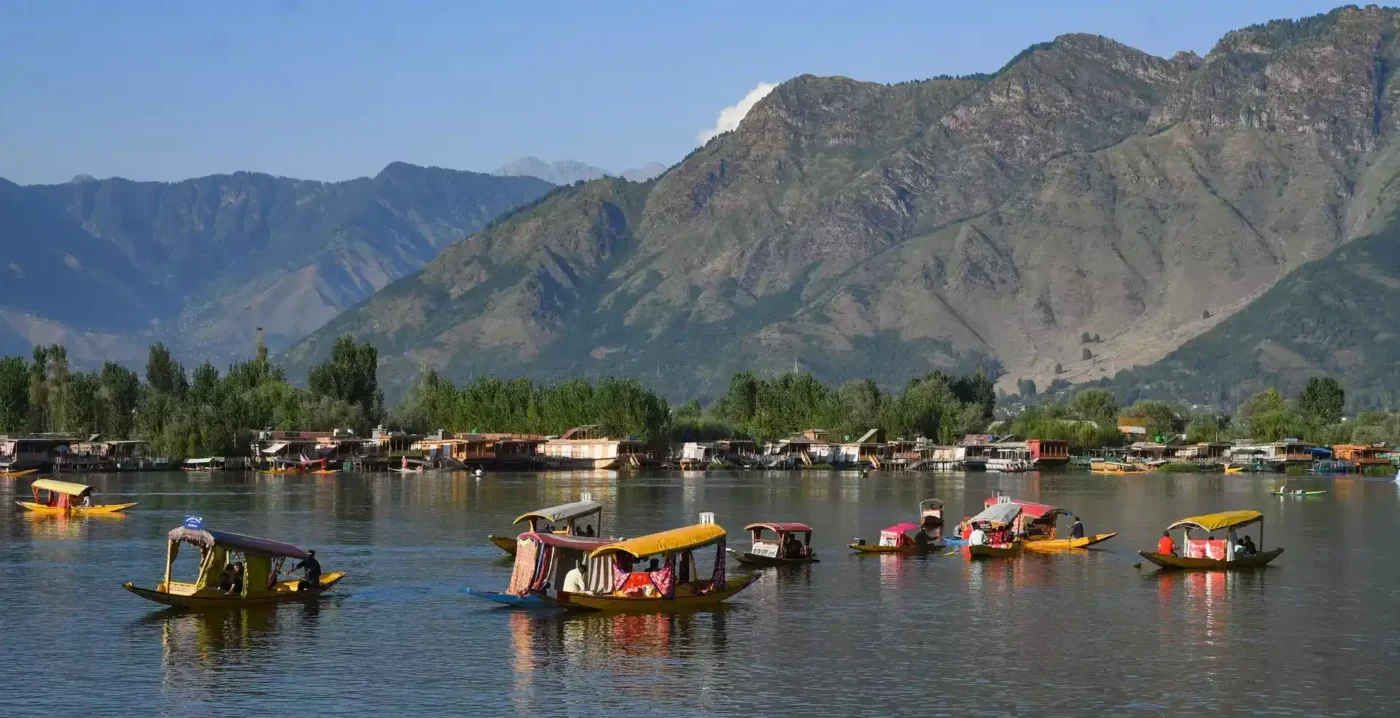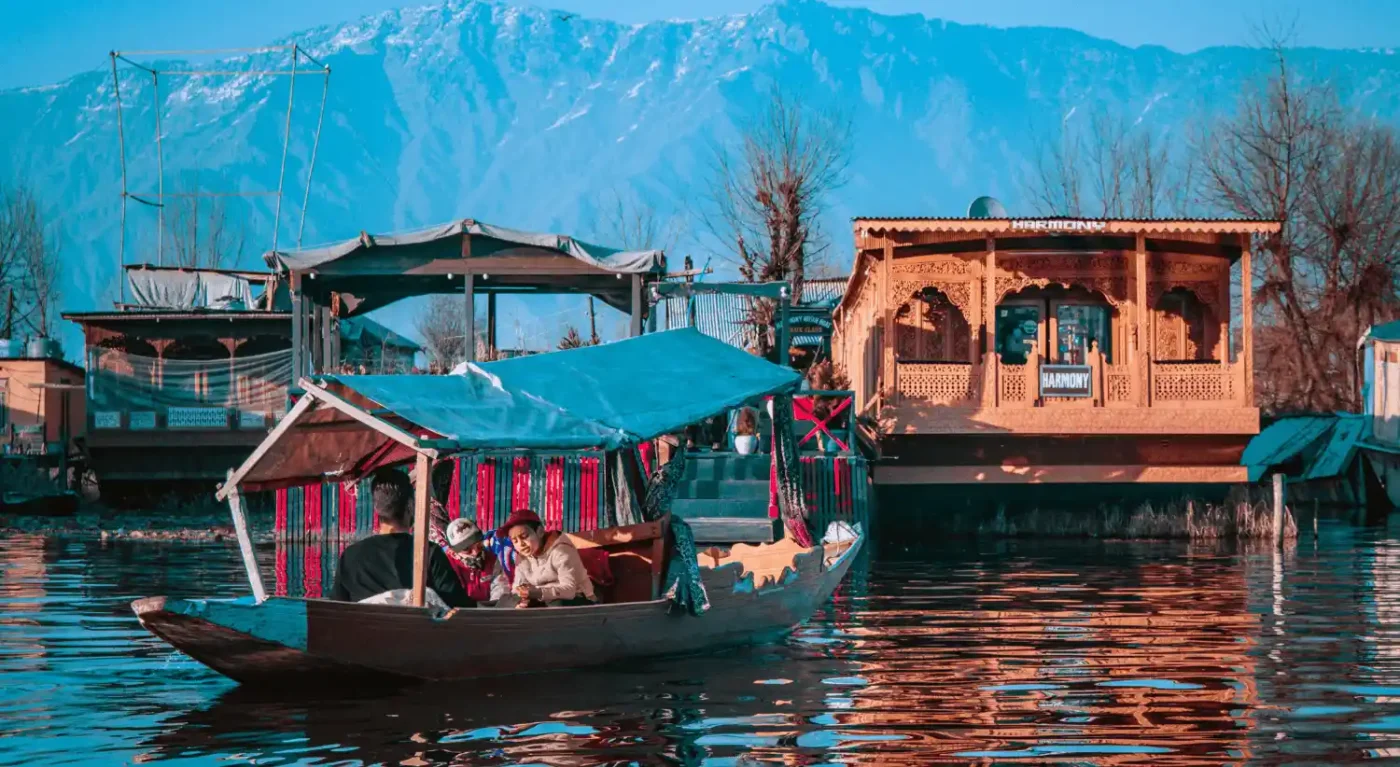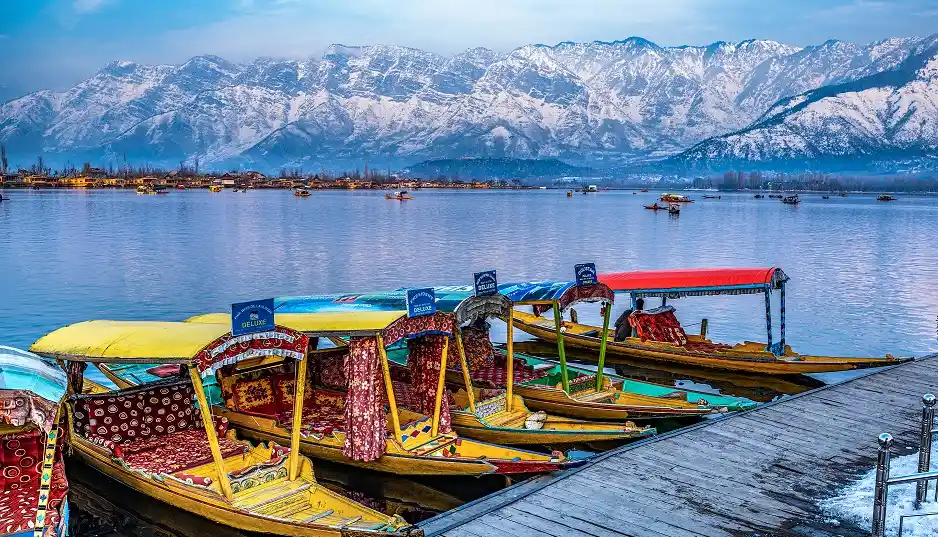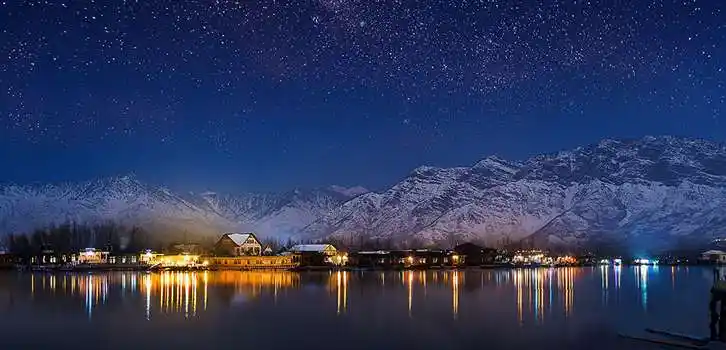Nestled in the heart of the Kashmir Valley, Dal Lake is a stunning natural wonder renowned for its picturesque landscapes, historical significance, and cultural richness. Often referred to as the “Jewel of Srinagar,” this lake captivates visitors with its serene waters, charming houseboats, and vibrant local traditions. Covering approximately 22 square kilometers and situated at an elevation of 1,583 meters (5,200 feet) above sea level, Dal Lake offers a multifaceted experience that ranges from tranquil boat rides to explorations of its rich historical and cultural backdrop. This comprehensive article delves into the various aspects of Dal Lake, including its geographical and historical significance, cultural importance, key attractions, activities, practical travel information, and conservation efforts.
Geographical Overview
Dal Lake is a central feature of Srinagar, the summer capital of Jammu and Kashmir. Its geographical setting and natural beauty make it a focal point of the Kashmir Valley.
1. Location and Extent
Dal Lake is situated in the northern part of Srinagar, surrounded by the lush landscape of the Kashmir Valley. The lake is approximately 7 kilometers (4.3 miles) in length and 3 kilometers (1.9 miles) in width, covering an area of about 22 square kilometers (8.5 square miles). It lies at an elevation of 1,583 meters (5,200 feet) above sea level, contributing to its unique climatic and ecological characteristics.
2. Surrounding Landscape
The lake is bordered by a picturesque landscape, including:
- Zabarwan Range: To the east of Dal Lake, the Zabarwan Range provides a stunning backdrop with its dense forests and scenic views.
- Pir Panjal Range: The western horizon of the lake is dominated by the Pir Panjal range, which adds to the lake’s dramatic scenery.
- Shankaracharya Hill: Overlooking the lake from the south is Shankaracharya Hill, home to an ancient temple that offers panoramic views of the lake and its surroundings.

3. Hydrology and Water Channels
Dal Lake is fed by several small streams and channels that flow from the surrounding hills and mountains. The lake is connected to the Jhelum River via the Nagin Lake and Wullar Lake, which help regulate its water levels and flow. The lake’s water is relatively shallow, with an average depth of 2 to 6 meters (6.6 to 19.7 feet), although some parts can be deeper.
4. Climate
Dal Lake experiences a temperate climate with distinct seasonal variations:
- Summer (March to June): Daytime temperatures range from 15°C to 30°C (59°F to 86°F), with pleasant weather that is ideal for boating and outdoor activities.
- Monsoon (July to September): The monsoon season brings moderate to heavy rainfall, replenishing the lake’s water levels and enhancing the surrounding greenery.
- Autumn (October to November): Autumn is characterized by cool temperatures and clear skies, making it a popular time for visitors to enjoy the lake’s beauty.
- Winter (December to February): Winters can be quite cold, with temperatures ranging from -2°C to 10°C (28°F to 50°F). Snowfall in the surrounding hills adds a magical touch to the lake’s landscape.
Historical Significance
Dal Lake’s historical importance is deeply rooted in the history of the Kashmir Valley. Its evolution reflects the region’s cultural and political changes over the centuries.
1. Ancient References and Early Settlements
Dal Lake has been mentioned in ancient Sanskrit texts and historical chronicles. Kalhana’s Rajatarangini, a 12th-century chronicle, describes the lake’s beauty and its significance to the local people. Early settlements around the lake date back to the ancient era, with local communities relying on the lake for water, transportation, and agriculture.
2. Mughal Era
The Mughal era marked a significant period in the history of Dal Lake. The Mughals, known for their love of gardens and natural beauty, were captivated by the lake’s scenic charm.
- Shalimar Bagh: Built by Emperor Jahangir in 1619 for his wife, Empress Nur Jahan, Shalimar Bagh is one of the most famous Mughal gardens surrounding Dal Lake. The garden features terraced levels, cascading fountains, and intricate floral designs.
- Nishat Bagh: Constructed by Empress Nur Jahan’s brother, Asif Khan, in 1633, Nishat Bagh, or the “Garden of Joy,” is known for its terraced layout, beautiful water channels, and panoramic views of the lake.
- Chashme Shahi: Also known as the “Royal Spring,” Chashme Shahi was built by Emperor Shah Jahan in 1632. The garden features natural springs, cascading fountains, and lush greenery.

3. British Colonial Period
During the British colonial period, Dal Lake attracted the interest of British administrators and explorers. The British sought an alternative to traditional hotels and inns, leading to the establishment of houseboats on the lake. This period marked the beginning of organized tourism in the region, with houseboats becoming a symbol of the area’s hospitality and unique lifestyle.
4. Modern Era
In the modern era, Dal Lake continues to be a major tourist destination, attracting visitors from around the world. Efforts have been made to preserve and promote the lake’s natural beauty and cultural heritage. The lake’s popularity has contributed to its status as a UNESCO World Heritage Site, reflecting its global significance.
Cultural Significance
Dal Lake is not only a natural wonder but also a cultural emblem of Kashmir. Its significance extends beyond its beauty to encompass its role in the local culture and traditions.
1. Houseboats
Houseboats are an iconic feature of Dal Lake, offering a unique and charming accommodation experience.
- Historical Evolution: The tradition of houseboats began in the 19th century when British visitors sought an alternative to traditional hotels. Over time, houseboats became a symbol of Kashmir’s hospitality and unique lifestyle.
- Architectural Features: Houseboats are typically made of wood and feature intricate carvings, ornate interiors, and traditional Kashmiri furnishings. They are equipped with modern amenities while retaining their classic charm.
- Cultural Experience: Staying on a houseboat provides guests with an immersive experience in Kashmiri culture. The boat owners often share local stories, traditions, and culinary delights with their guests.
2. Shikara Rides
Shikara rides are a popular activity on Dal Lake, offering a peaceful and scenic way to explore the lake.
- Traditional Boats: Shikaras are traditional wooden boats adorned with vibrant floral patterns. They are steered by local boatmen who navigate the lake’s waterways.
- Local Interaction: During a Shikara ride, visitors can interact with local vendors selling handicrafts, flowers, and snacks. This interaction provides a glimpse into local life and traditions.
- Special Occasions: Shikara rides can be customized for special occasions, such as romantic dinners or family gatherings, with options for decorated boats and personalized services.
3. Cultural Festivals
Dal Lake is often a focal point for local festivals and cultural events.
- Shikara Festival: The Shikara Festival, held annually, celebrates the cultural significance of Shikara rides. The festival features boat races, cultural performances, and traditional music.
- Religious Events: Various religious festivals and events are celebrated around Dal Lake, reflecting the region’s diverse cultural and religious heritage.
4. Local Cuisine
Kashmiri cuisine is influenced by the lake’s cultural significance and features a variety of traditional dishes.
- Kashmiri Delicacies: Local restaurants and eateries around Dal Lake serve traditional Kashmiri dishes, including Rogan Josh (a spiced lamb curry), Yakhni (a yogurt-based curry), and Kehwa (a saffron tea). These dishes reflect the region’s culinary heritage and are enjoyed by visitors and locals alike.

Key Attractions
Dal Lake offers a range of attractions that showcase its natural beauty, historical significance, and cultural heritage.
1. Mughal Gardens
The Mughal gardens surrounding Dal Lake are renowned for their beauty and historical significance.
- Shalimar Bagh: Known as the “Crown of Srinagar,” Shalimar Bagh is a stunning Mughal garden with terraced levels, cascading fountains, and intricate floral designs. It was built by Emperor Jahangir for his wife, Empress Nur Jahan.
- Nishat Bagh: The “Garden of Joy,” Nishat Bagh features a series of terraced levels with beautiful water channels and panoramic views of the lake and surrounding mountains. It was constructed by Empress Nur Jahan’s brother, Asif Khan.
- Chashme Shahi: This Mughal garden, also known as the “Royal Spring,” is famous for its natural springs, cascading fountains, and lush greenery. It was built by Emperor Shah Jahan.
2. Hazratbal Shrine
The Hazratbal Shrine is a significant religious site located on the northern shores of Dal Lake.
- Religious Significance: The shrine houses a relic believed to be a hair strand of the Prophet Muhammad. It is a revered site for Muslims and attracts visitors from across the region.
- Architectural Beauty: The shrine is known for its white marble architecture and serene setting, offering a peaceful place for reflection and worship.
3. Pari Mahal
Pari Mahal, also known as the “Palace of the Fairies,” is a historical monument situated on the slopes of the Zabarwan Range.
- Historical Landmark: Built by Dara Shikoh, the eldest son of Emperor Shah Jahan, Pari Mahal showcases Persian architectural influences and intricate garden designs.
- Architectural Features: The seven-
terraced garden offers stunning views of Dal Lake and the surrounding area.
4. Botanical Gardens
The botanical gardens around Dal Lake are known for their vibrant floral displays and natural beauty.
- Indira Gandhi Memorial Tulip Garden: Located on the foothills of the Zabarwan Range, this garden is famous for its annual tulip displays. The garden hosts a flower festival during the tulip blooming season, attracting visitors from around the world.
Activities and Experiences
Dal Lake offers a variety of activities and experiences that cater to different interests and preferences.
1. Shikara Rides
Shikara rides are a quintessential activity on Dal Lake, providing a leisurely and scenic way to explore the lake.
- Leisurely Boating: Shikara rides offer a peaceful experience, allowing visitors to enjoy the lake’s beauty and tranquility. Boatmen often share local stories and information about the lake’s history.
- Special Occasions: Shikara rides can be customized for special occasions, such as romantic dinners or family gatherings. Boats can be decorated with flowers and candles to enhance the experience.
2. Houseboat Stays
Staying on a houseboat is a unique and memorable experience that offers insight into Kashmiri culture.
- Traditional Accommodation: Houseboats are equipped with modern amenities while retaining their traditional charm. Guests can enjoy the picturesque setting and warm hospitality.
- Cultural Experience: Houseboat stays provide an opportunity to experience local traditions, cuisine, and lifestyle. Boat owners often share stories and cultural insights with their guests.
3. Fishing
Dal Lake offers opportunities for fishing, with various species of fish found in its waters.
- Angling Opportunities: Local fishermen provide guidance and equipment for those interested in fishing. The lake’s shallow waters make it accessible for anglers of all levels.
4. Photography
The scenic beauty of Dal Lake offers excellent opportunities for photography.
- Scenic Views: The lake’s landscapes, including the surrounding mountains, gardens, and reflections on the water, provide stunning photographic subjects. Sunrise and sunset are particularly ideal times for capturing the lake’s beauty.
- Wildlife Photography: The lake’s surrounding areas are home to various bird species and wildlife, making it a great location for nature and wildlife photography.
5. Local Markets
The markets around Dal Lake offer a variety of local handicrafts, textiles, and souvenirs.
- Shopping: Visitors can explore markets such as Lal Chowk and Polo View Market, where they can purchase traditional Kashmiri items, including Pashmina shawls, carpets, and Kashmiri saffron.

Practical Travel Information
1. Getting There
Dal Lake is accessible by various modes of transportation, including air, train, and road.
- By Air: The nearest airport to Dal Lake is Sheikh ul-Alam International Airport (Srinagar Airport), located approximately 12 kilometers (7.5 miles) from the lake. The airport is well-connected to major Indian cities, including Delhi, Mumbai, and Bangalore.
- By Train: The nearest railway station is Jammu Tawi Railway Station, about 290 kilometers (180 miles) from Srinagar. From Jammu, travelers can take a taxi or bus to reach Srinagar.
- By Road: Srinagar is well-connected by road to various cities in northern India. The journey by road offers scenic views of the Himalayan landscape.
2. Best Time to Visit
The best time to visit Dal Lake depends on personal preferences and the type of experience desired.
- Spring (March to May): Spring is ideal for visiting, with pleasant weather and blooming flowers. It is also the time for the tulip festival in the Indira Gandhi Memorial Tulip Garden.
- Summer (June to August): Summer offers warm temperatures and clear skies, making it a great time for outdoor activities and sightseeing.
- Autumn (September to November): Autumn provides beautiful fall colors and a pleasant climate, ideal for enjoying the lake’s beauty.
- Winter (December to February): Winter offers a unique experience with snow-covered landscapes. However, temperatures can be quite cold, and some activities may be limited.
3. Accommodation
Dal Lake offers a range of accommodation options, including houseboats, hotels, and resorts.
- Houseboats: Staying on a houseboat is a popular option, with various levels of luxury and comfort available. Notable houseboat operators include The Houseboat Company and New Shaheen Houseboats.
- Hotels: Several hotels and resorts are located around Dal Lake, offering a range of accommodation options. Popular choices include the Lalit Grand Palace and Hotel Paradise.
4. Health and Safety
- Altitude: While Dal Lake is at a relatively moderate altitude, travelers should be mindful of potential altitude sickness. Staying hydrated and acclimating gradually is advisable.
- Travel Insurance: It is recommended to have travel insurance to cover unforeseen events and emergencies.
- Local Customs: Visitors should respect local customs and traditions. It is advisable to dress modestly and be mindful of religious and cultural practices.
Conservation Efforts
Dal Lake faces various environmental challenges, including pollution, encroachment, and habitat degradation. Several conservation efforts are underway to preserve and protect the lake’s natural beauty and ecological balance.
1. Pollution Control
Efforts to control pollution include:
- Waste Management: Initiatives to improve waste management and reduce pollution from domestic and industrial sources are crucial for maintaining the lake’s water quality.
- Awareness Campaigns: Public awareness campaigns aim to educate locals and visitors about the importance of keeping the lake clean and reducing pollution.

2. Habitat Restoration
Restoration projects focus on:
- Wetland Restoration: Efforts to restore and protect wetland areas around the lake help maintain the ecological balance and support local wildlife.
- Reforestation: Planting trees and restoring vegetation in the surrounding hills and banks help prevent soil erosion and improve water quality.
3. Sustainable Tourism
Promoting sustainable tourism practices includes:
- Eco-Friendly Practices: Encouraging eco-friendly practices among tourists, such as minimizing waste and respecting local wildlife, helps reduce the impact on the environment.
- Regulations: Implementing regulations to control the number of visitors and manage tourism activities ensures that the lake’s natural resources are preserved for future generations.
4. Government and NGO Initiatives
Government agencies and non-governmental organizations (NGOs) are actively involved in conservation efforts.
- Government Programs: The Jammu and Kashmir government has launched various programs and projects to address environmental issues and promote sustainable development.
- NGO Involvement: NGOs and community-based organizations play a significant role in raising awareness, implementing conservation projects, and advocating for the protection of Dal Lake.
Conclusion
Dal Lake, with its enchanting beauty, rich history, and vibrant cultural heritage, remains one of Kashmir’s most iconic and beloved destinations. From its serene waters and charming houseboats to its historical landmarks and local traditions, the lake offers a diverse range of experiences for visitors. Exploring Dal Lake provides an opportunity to immerse oneself in the timeless allure of Kashmir’s natural splendor and cultural richness. As efforts continue to preserve and protect this remarkable lake, Dal Lake will undoubtedly continue to captivate and inspire travelers for generations to come.
